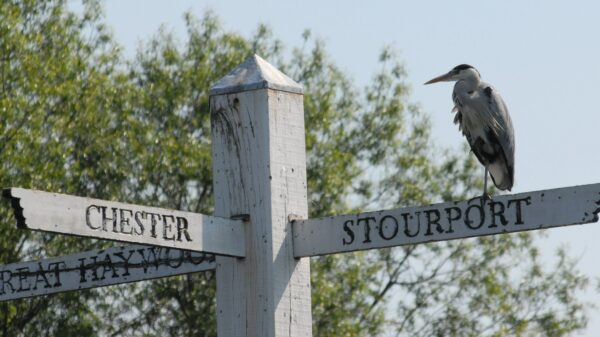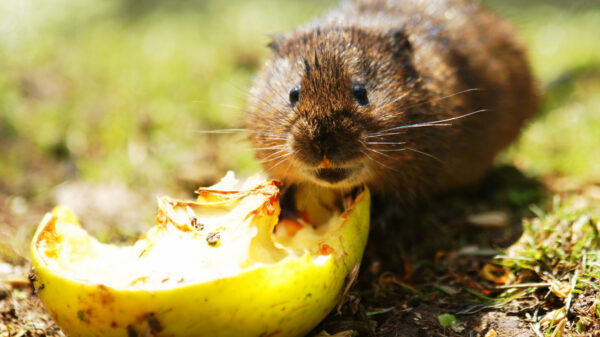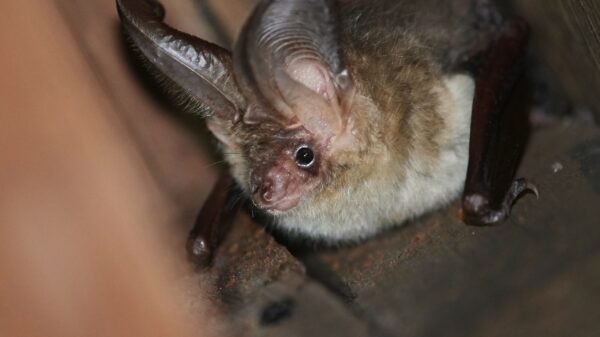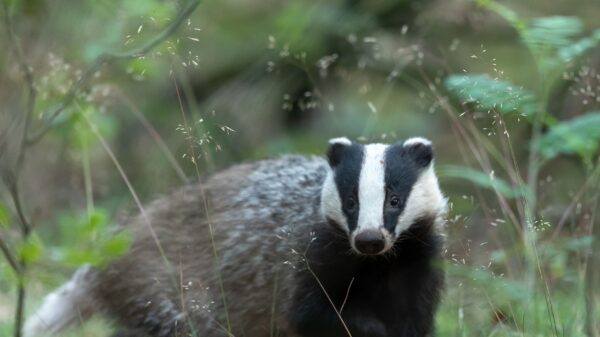Restoration Hub > Environmental Toolkit > Protected Species: Bats
Restoration Hub
Protected Species: Bats
Bats in the UK
There are 18 species of bat in the UK, 17 of which are known to actively breed. Bats make up a quarter of the mammal species found in the UK. You can find them all over the country in the countryside, towns and cities, becoming significantly more active throughout the summer months when foraging. Depending on the species and time of year bats can be found across a variety of environments hibernating, forging, commuting or rearing their young.
Bats on Waterways
Waterways act as a massive network allowing bats to both hunt along and commute from roosts to feeding sites across our varied landscape, making canals and rivers an important environment linked to the success of bats. Many features along our waterways also provide opportunities for bats to thrive:
Roosting: Bridges, houses, barns, and trees are just some examples that bats will use for roosting purposes. In the summer months female bats will often form maternity roosts to raise their young. During autumn and winter bats will start heading off to hibernation roosts generally preferring cool and consistent temperatures away from disruption and predators. Cracks and crevices can be accessed for roosts from as little as 50mm deep and 12mm wide!
Foraging: All UK bats are insectivores and will hunt for insects on wing, meaning that they will mainly catch and eat prey whilst in flight. Some species are being able to eat over 3000 insects per night! Waterways attract the large volume of insects required to support bat populations.
Commuting: The distance bats travel to feeding sites varies depending on species, Noctule bats (Nyctalus noctula) have been recorded travelling up to as far as 26km in one night. With over 6500 miles of navigable and derelict canal with linear features intersecting a variety of habitats, waterways such as canals and the habitats surrounding them are important factor for all bat.
Protection Status
All bat species are listed on Schedule 5 on the Wildlife and Countryside Act (1981). This means that it is an “illegal offence to intentionally kill, injure or take any wild animal listed on Schedule 5 and prohibits interference with places used for shelter or protection, or intentionally disturbing animals occupying such places” unless under specified circumstances. The maximum fine on conviction of offences is currently £5,000. Seven of the eighteen bat species are also listed as a UK Biodiversity Action Plan (UKBAP) priority species. This means that species identified as being the most threatened and requiring conservation action and will have specific conservation management plans in place.
The following legislation offers protection to UK bats:
- Wildlife and Countryside Act 1981: England, Scotland and Wales
- Countryside and Rights of Way (CROW) Act 2000: England and Wales
- Nature Conservation (Scotland) Act 2004: Scotland
- Habitats Directive (Council Directive 92/43/EEC) on the Conservation of Natural Habitats and of Wild Fauna and Flora.
Structures (artificial or natural) that are inhabited or used by bats for shelter are protected by law, prohibiting the intentional damage or destruction of these places. It may be necessary for local planning authorities or developers to conduct bat surveys to determine the potential presence on site, the likelihood of the site for bat use and whether bat roosts are likely to be affected from the proposed development. If bats are found, planning can be delayed and an appropriate person can be contacted to legally translocate the bats, if permission to do so is granted.
Bats and canal restoration
When planning projects it is important to consider if the site could potentially house a bat roost. Bat surveys can be undertaken to assess a site for presence, activity, roosting and abundance. Projects and activity on waterways can directly interfere with bats, such work includes bridge restoration and demolition, tree felling, brick work and scrub bashing. These can destroy roosts, remove commuting routes and impact foraging areas.
Bats and Bridges
Stone bridges are most likely to provide a suitable roost sites, especially if located over water, but you can also find bats in concrete bridges or within wood ones. Bats can be found in crevices such as gaps between the brick work, drainage holes, expansion joints, gaps and cracks as well as voids and gaps within concrete structures. Work on bridges can have a direct effect on bats roosting within them, tasks such as re-pointing, rebuilding and demolition can injure or kill bats and even painting or timber treatments can affect them. If such work disturbs, injures or kills a bat or damages the area in which they are roosting, the work will be considered illegal unless correct procedure is followed. If a bat is found during the works then all work must be ceased and advice given by the appropriate Statutory Nature Conservation Organisation (SNCO). To maintain best practice it is advised that you should contact your local SNCO in advance of works preferably with one year in advance of planned works.
What should I do if I am planning on undertaking bridge work?
Certain measures can be followed to avoid damage or disturbance to potential bat roosts, when planning bridge work. They are as follows:
- Be aware that there is a possibility of finding a bat roost during an inspection
- Identify and note signs of bat roosts or potential roosts in work schedules
- Ensure relevant information is passed on to the appropriate SNCO or local bat group, as well as to those who will be conducting the work
What if I have bats roosting in a bridge with work due to be undertaken?
If your bridge does have a bat roost then a Habitats Regulation License (HBR) must be applied for. A Survey for bats will also need to be undertaken by a bat specialist, who will apply for the HBR and provide options for mitigation such as:
- Carefully timed work, with regards to breeding or hibernating bats
- Hand pointing in sensitive areas, such as in areas where cracks and crevices are to be retained
- Ensuring roosts remain intact wherever possible
- Creating new roost sites, where roosts are to be lost. With Bat Bricks or boxes being potentially incorporated into the bridge
Bats and Buildings
All UK bat have been known to roost in buildings, although some a more common sight than others. The most commonly found bats in buildings are the Pipistrelle bats (common pipistrelle, soprano pipistrelle and the rarer Nathusius pipistrelle) and Brown long-eared bats. The different species of bat tend to prefer differing conditions which varying roosts can offer. Certain features offer contrasting conditions for bats to roost in.
Potential roosts in buildings
Bat roosts can be found in and around buildings, wherever there is a gap, there is a potential for a bat roost. Areas most commonly used outside are under weather boards or hanging tiles, inside cavity walls, in gaps behind cladding tiles, between window frame and wall brickwork, between under felt and boards or tiles or above soffits and behind fascia and barge boarding. Inside they can be found along ridge beams, around the gable end or on the chimney breast.
What should I do if I am planning on undertaking building work?
There are certain measures that can be followed to avoid damage or disturbance to potential bat roosts, when planning building work. They are as follows:
- Be aware that there is a possibility of finding a bat roost during an inspection
- Identify and note signs of bat roosts (primarily droppings) or potential roosts in work schedules
- Ensure relevant information is passed on to the appropriate SNCO or local bat group, as well as to those who will be conducting the work
What if I have bats roosting in a building with work due to be undertaken?
If your building does have a bat roost within it and work is likely to affect bats or roosts, alert the appropriate SNCO or governmental body to any work that could cause damage to an existing or potential roost and they will be able to offer advice. Work that will affect other buildings, structures or trees then a Habitats Regulation License (HBR) must be applied for. A Survey for bats will also need to be undertaken by a bat specialist, who will apply for the HBR and provide options for mitigation such as:
- Carefully timed work, with regards to breeding or hibernating bats
- Ensuring roosts remain in tact wherever possible
- Creating new roost sites, where roosts are to be lost. With Bat Bricks or boxes being potentially incorporated onto the bridge
- Advise whether work may continue based on the potential risks to the roost
Bats and Forestry
Trees are an essential aspect of bat ecology, with three quarters of UK bats species known to roost within trees, some using the exclusively for roosting purposes and others during parts of the year. However all species are known to forage within and surrounding woodlands. Any tree has the potential to be a roost site for bats and it is important in being able to recognise the signs and assess the likelihood of a tree to be a roost site.
Surveying for bats
Certain features within trees can indicate the potential for harbouring a roost. The features that are indicatory of ‘High Potential’ are:
- Woodpecker Holes
- Flaking bark
- Crack and crevices within branches or trunk
- Dense ivy cover
- Holes at the buttresses and hollow core
- Deadwood within canopy
- Snagged branches
Once these features have been identified the presence of bats can be identified from evidence surrounding the potential roosts. Things to look for include: Staining surrounding the hole from the natural oils with bat fur, staining beneath the hole from urine, excrement/droppings can also be found beneath a hole, scratch marks from their claws, insects flying around a hole can indicate the presence of wildlife and bats emerging from the features at dusk and retuning during dawn.
Recording and assessment
During the surveys, trees should recorded for features, descriptions and location. Assessing the surveys outcome and indicating the trees bat potential will offer clues in the best management options for those trees.
Planning tree work
Prior to conducting tree work it is important to check local record centres, statutory nature conservation organisations (SNCO) or local councils for any known bat roosts or other significant species. A survey is then recommended to be carried out to look out for bat potential and other evidence. Assessing the data will highlight the trees potential as a roosting site; taking pictures will help analysis later on. Alert the contracted tree workers on the ‘high potential’ roost trees and take account of this. A tree is deemed to have ‘high potential’ will not stop work, but this does mean that advice should be sought on how to complete works legally. It may be easier to recruit the assistance of an experienced ecologist to survey the trees within an area to prevent undue delays in the work.
Conducting the work
Best practice indicates that where possible retain ivy, dead and dying trees unless the tree is a cause for concern. Depending on the results of the survey acquiring appropriate permissions and licences may be required especially for carrying out work on high potential trees. Leaving wood on site for a 48hour period after cutting will provide an opportunity for bats potentially roosting in a felled tree to escape, whilst leaving the wood indefinitely proves another important habitat for invertebrates and other species. If bats are found during works than all work should cease immediately and an appropriate license acquired from Natural England.
After care
Habitat improvement works can be implemented on sites where significant habitat loss of change has occurred. For example placing bat boxes, leaving deadwood, planting native trees can all assist in compensating habitat loss and improve the local environment for all users.
Our use of cookies
We use necessary cookies to make our site work. We'd also like to set optional analytics cookies to help us improve it. For more detailed information about the cookies we use, see our 'Cookie Policy page'.Edit preferences Accept
Privacy Overview
| Cookie | Duration | Description |
|---|---|---|
| __stripe_mid | 1 year | Stripe sets this cookie to process payments. |
| __stripe_sid | 30 minutes | Stripe sets this cookie to process payments. |
| cookielawinfo-checkbox-advertisement | 1 year | Set by the GDPR Cookie Consent plugin, this cookie records the user consent for the cookies in the "Advertisement" category. |
| cookielawinfo-checkbox-analytics | 1 year | Set by the GDPR Cookie Consent plugin, this cookie records the user consent for the cookies in the "Analytics" category. |
| cookielawinfo-checkbox-functional | 1 year | The GDPR Cookie Consent plugin sets the cookie to record the user consent for the cookies in the category "Functional". |
| cookielawinfo-checkbox-necessary | 1 year | Set by the GDPR Cookie Consent plugin, this cookie records the user consent for the cookies in the "Necessary" category. |
| cookielawinfo-checkbox-others | 1 year | Set by the GDPR Cookie Consent plugin, this cookie stores user consent for cookies in the category "Others". |
| cookielawinfo-checkbox-performance | 1 year | Set by the GDPR Cookie Consent plugin, this cookie stores the user consent for cookies in the category "Performance". |
| CookieLawInfoConsent | 1 year | CookieYes sets this cookie to record the default button state of the corresponding category and the status of CCPA. It works only in coordination with the primary cookie. |
| PHPSESSID | session | This cookie is native to PHP applications. The cookie stores and identifies a user's unique session ID to manage user sessions on the website. The cookie is a session cookie and will be deleted when all the browser windows are closed. |
| Cookie | Duration | Description |
|---|---|---|
| _fbp | 3 months | Facebook sets this cookie to display advertisements when either on Facebook or on a digital platform powered by Facebook advertising after visiting the website. |
| _ga | 1 year 1 month 4 days | Google Analytics sets this cookie to calculate visitor, session and campaign data and track site usage for the site's analytics report. The cookie stores information anonymously and assigns a randomly generated number to recognise unique visitors. |
| _ga_* | 1 year 1 month 4 days | Google Analytics sets this cookie to store and count page views. |
| _gat_gtag_UA_* | 1 minute | Google Analytics sets this cookie to store a unique user ID. |
| _gat_UA-* | 1 minute | Google Analytics sets this cookie for user behaviour tracking.n |
| _gid | 1 day | Google Analytics sets this cookie to store information on how visitors use a website while also creating an analytics report of the website's performance. Some of the collected data includes the number of visitors, their source, and the pages they visit anonymously. |
| CONSENT | 2 years | YouTube sets this cookie via embedded YouTube videos and registers anonymous statistical data. |
| Cookie | Duration | Description |
|---|---|---|
| test_cookie | 15 minutes | doubleclick.net sets this cookie to determine if the user's browser supports cookies. |
| VISITOR_INFO1_LIVE | 5 months 27 days | YouTube sets this cookie to measure bandwidth, determining whether the user gets the new or old player interface. |
| YSC | session | Youtube sets this cookie to track the views of embedded videos on Youtube pages. |
| yt-remote-connected-devices | never | YouTube sets this cookie to store the user's video preferences using embedded YouTube videos. |
| yt-remote-device-id | never | YouTube sets this cookie to store the user's video preferences using embedded YouTube videos. |
| yt.innertube::nextId | never | YouTube sets this cookie to register a unique ID to store data on what videos from YouTube the user has seen. |
| yt.innertube::requests | never | YouTube sets this cookie to register a unique ID to store data on what videos from YouTube the user has seen. |






